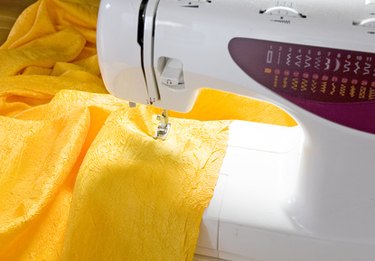
Sewing machines, like all motor-based devices, can become warm to the touch when their motors have run steadily. While a little heat is not a problem, a hot motor can lead to potential overheating, which is not good for the machine. Also, many sewing machines automatically shut off when they are at risk of overheating. Being informed about what causes a sewing machine’s motor to get too hot will keep you, and your sewing projects, running smoothly.
Identification
Video of the Day
The housing around the motor on a sewing machine may become hot to the touch as you sew. Some heat is normal. If the area heats up more quickly than usual, or if you smell a burning or electrical odor, the problem may be more serious.
Video of the Day
Causes
A number of reasons can cause a sewing machine motor to labor harder than usual, and, therefore, become too hot. One reason is running the motor for a prolonged period at a low speed. Another culprit, according to SewVacDoctor.com, can be a motor that has not been properly lubricated or oiled. The motor also may get unusually hot if a thread is caught within the machine's mechanisms. Each of these problems causes the motor to work too hard, which can be detrimental to the machine.
Solutions
If the area around a sewing machine’s motor becomes more hot than usual, or if the motor begins to emit a burning or electrical odor, the machine should be turned off and unplugged. A motor that was run continuously requires about 20 minutes to recuperate. Meanwhile, the thread should be removed from the needle and the bobbin from its spool to ensure no threads are caught in any of these mechanisms. In addition, a machine that hasn’t been cleaned and oiled regularly according to its manufacturer’s directions should be cleaned and oiled. If the problem persists, a sewing machine dealer can service the machine to eliminate other problems.
Prevention
To prevent a sewing machine from getting too hot, and to avoid the risk of it shutting itself off because of overheating, it is important to take good care of the machine. Cleaning and oiling a sewing machine regularly is a vital step in maintaining its health. It's also important to avoid running a machine for extended periods of time at low speeds and to take care of tangled threads immediately so they don't cause bigger problems.
Considerations
Because every sewing machine is different, it is necessary to follow a particular machine's manufacturer instructions for care. Keeping the machine's printed manual handy when you sew is beneficial. Most manufacturers offer replacement manuals through their website, and some offer online or printable versions for free.